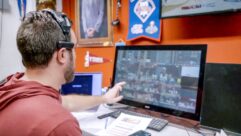SAFETY HARBOR, FLORIDA – MAY 2013:
Marko Hunt is closing in on four decades behind the mixing console, and he has spent the last thirty-two of them with The Oak Ridge Boys – first at monitors and then later at FOH. Before securing that enduring gig, Hunt cut his teeth touring with the Little River Band in its heyday. He also spent several years touring with Johnny Cash. Suffice it to say, Hunt is no newbie! And after all those countless gigs in the innumerable venues of the nation and the world, he can hear things with awe-inspiring precision and objectivity, although he’s too modest and soft-spoken to admit it. Perhaps because of that ability, Hunt is also keenly aware of the multiple advantages of regularly “calibrating” his ears with the analysis software that has been his constant companion for the last decade: SpectraFoo by Metric Halo.
“As good as my ears may or may not be (that’s an opinion!) it’s still a good idea to use a measurement tool to maintain accuracy,” Hunt said. “Anybody who does what I do knows that there are so many things in a room that can throw you off. I can hear a frequency and call it. By now, I’m good at that. But I can still get fooled; it’s not uncommon to mistake a frequency for one that’s an octave higher or lower. Moreover, I’m used to calling frequencies in the standard 1/3 octave bands. But with SpectraFoo, I can objectively see what’s going on with much greater resolution, switching to 1/6 or even 1/12 octave, which allows me to pinpoint a frequency on my parametric EQ. Very often, that center point may sit between the 1/3 octave bands.”
In addition to the tricks and phantoms that acoustical spaces and PA systems love to conjure, there are often physiological reasons why the objectivity afforded by SpectraFoo and Hunt’s Earthworks M30 omni-directional measurement microphone can be a life saver. “Because of the timing of things, there are some days when I go over the mountains flat on my back in a bunk,” he said. “God never meant for you and your ears to go over the mountains on your back! Or I may fly, and the pressure change may leave my ears completely whacked. But my computer doesn’t care. My mic doesn’t care. And SpectraFoo doesn’t care. I can still tune a room – close to perfectly – even if my ears are still recovering.”
When working with The Oak Ridge Boys, a well-tuned room is essential. With four vocalists, four soloists, and percussion, there is a lot going on and a lot of open mics. Indeed, the high pass for bass vocalist Richard Sterban (think “oom-pa-pa-oom-pa-pa-mau-mau” from “Elvira”) is often as low as 80Hz, and he’s a fairly quiet singer. If Hunt doesn’t take care of the 200 to 300Hz especially, his mix will invariably turn to mud. “Although I travel with my own console, every night I’m faced with a different room and a different PA,” he said. “SpectraFoo helps me to maintain consistency from night to night.” Of course, Hunt also relies on his ears – you can often find him walking around a venue before a show listening to Steely Dan, Diana Krall, Herbie Hancock, Chick Corea and other “clean recordings” that he’s very familiar with.
Apart from helping Hunt to objectify his experience, SpectraFoo can also make it easier to communicate with others about sound, which can otherwise be a very subjective topic of conversation – or of disagreement. “I remember one time when I was setting up, and the left side of the PA sounded funny,” he said. “I talked with the venue technicians, who insisted that they had just had someone out to tune things up and that the problem must therefore reside with our gear. So I showed them with SpectraFoo: first the right side where everything looked good, then the left side, where things were obviously messed up. Then they said, ‘it has to be your console!’ So I hooked up the console output to SpectraFoo and it was obvious that both channels were fine. They couldn’t fix it that day, but they did call me later to say thanks and that, yes, a few of the components had been wired out of phase.”
Although he doesn’t use them all, Hunt appreciates the huge diversity of tools available in SpectraFoo, and he uses a fair number of them – both on the road and in the studio. “The main tools that I use for tuning a room and for the actual performance are the Spectragraph (volume versus frequency) and the Spectragram (volume versus frequency versus time),” said Hunt. “I’ll usually compare the output from the console with the output from my Earthworks mic using the Transfer Function (source versus mic). If I hear a frequency poke up, I can turn to the time-based Spectragram, and that lets me know where it is and whether it’s in the console or only in the room.” He uses many of the additional tools, such as the oscilloscope, the Lissajous phase scope, THD Distortion Analyzer and the Phase Torch to confirm the operation of his equipment and to help out in the studio. “I also can route my monitor buss to the source input and compare any channel on the console to what’s coming out of the P.A. or using separate busses compare any two channels on the console, i.e. kick and bass guitar. Once you’re set up it’s as simple as switching window sets.”
ABOUT METRIC HALO
Now based in the sunny city of Safety Harbor, Florida, Metric Halo provides the world with high-resolution metering, analysis, recording and processing solutions with award-winning software and future-proof hardware.










